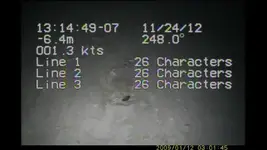I have been setting out on the sidelines on this one up until now as I have had very little forum time to post. After looking at the image in post #13, I tend to agree with JT (post #16); however, other possibilities exist. Having 30-years experience as a mechanical and Civil municipal designer, including piping design, I believe the pipe resembles a mechanical joint type of fitting. I used such fittings in a design at Coastal Fuels in Miami, whereas, Steel (316SS) flanged pipe was used for above ground piping; Mechanical Joint piping was used for below grade (for other than fuel transfer applications); and, bell fittings (also 316SS) were used for suspension by crane to provide supply between the tank farm and the fuel tanker, reasoning this type of fitting allows the most deflection to arc the pipe assembly over to the ship. I do not know if MJ fittings were used on the tankers, however, it is possible. If it is dredging pipe--most dredging piping that I have seen is flanged-type, thus allowing quicker assembly and disassembly. It does not apear to be that. Yet, these styles of pipe end designs date back into the nineteenth century, and some designs--into the late-1700's for steam applications. The same design was also used on some early deck-mounted capstan and compass bases. Just a thought to throw out there...



 even though I know different.
even though I know different.



